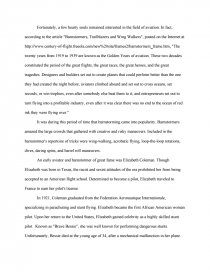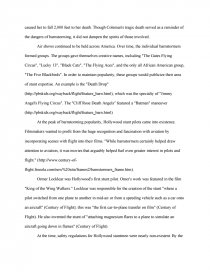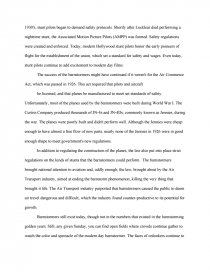Barnstormers: Trailblazers of the Sky
Essay by review • February 8, 2011 • Research Paper • 1,362 Words (6 Pages) • 1,228 Views
Barnstormers: Trailblazers of the Sky
"Barnstormer" is one of the most illustrative words in the English language. It brings to mind images of brightly painted propeller planes, piloted by leather clad figures, breezing through clear blue skies over faded wooden buildings, thrilling crowds of onlookers with the dramatic performance of dangerous stunts. These images are so vivid that one can almost smell the scent of freshly cut hay floating on the light wind; almost hear the high pitched whine of the plane's propellers as they cut through the crisp spring air. Barnstormers were pioneers in the early years of aviation. Their daring, passion, creativity and competitive spirit contributed greatly to the advancement of flight. Without the substantial achievements of these brave men and women, aviation might not have progressed to the important industry and widespread mode of transportation that it is today.
During World War I, the military played a significant role in the American economy, as well as the economies of most of the countries in Europe. Sizeable military budgets provided the funding to pay soldier's salaries, financed the construction and operation of factories, and provided investment capital to numerous industries, including the industry of aviation.
When World War I ended in 1918, the investment into the aeronautics industry changed dramatically. According to the article "Barnstormers, Trailblazers and Wing Walkers", posted on the Internet at http://www.century-of-flight.freeola.com/new%20site/frames2/barnstormers_frame.htm, "air services were cut back to skeleton strength, and governments made a sober determination that aviation had made a minimal contribution to the war effort, certainly not warranting the kind of money spent." The American government's conclusion that the cost of aviation was greater than its benefit resulted in decreased investment into the emerging technology, as well as reduced public interest in the burgeoning industry.
Fortunately, a few hearty souls remained interested in the field of aviation. In fact, according to the article "Barnstormers, Trailblazers and Wing Walkers", posted on the Internet at http://www.century-of-flight.freeola.com/new%20site/frames2/barnstormers_frame.htm, "The twenty years from 1919 to 1939 are known as the Golden Years of aviation. These two decades constituted the period of the great flights, the great races, the great heroes, and the great tragedies. Designers and builders set out to create planes that could perform better than the one they had created the night before; aviators climbed aboard and set out to cross oceans, set records, or win trophies, even after somebody else beat them to it; and entrepreneurs set out to turn flying into a profitable industry, even after it was clear there was no end to the ocean of red ink they were flying over."
It was during this period of time that barnstorming came into popularity. Barnstormers amazed the large crowds that gathered with creative and risky maneuvers. Included in the barnstormer's repertoire of tricks were wing-walking, acrobatic flying, loop-the-loop rotations, dives, daring spins, and barrel roll maneuvers.
An early aviator and barnstormer of great fame was Elizabeth Coleman. Though Elizabeth was born in Texas, the racist and sexist attitudes of the era prohibited her from being accepted to an American flight school. Determined to become a pilot, Elizabeth traveled to France to earn her pilot's license.
In 1921, Coleman graduated from the Federation Aeronautique Internationale, specializing in parachuting and stunt flying. Elizabeth became the first African American woman pilot. Upon her return to the United States, Elizabeth gained celebrity as a highly skilled stunt pilot. Known as "Brave Bessie", she was well known for performing dangerous stunts. Unfortunately, Bessie died at the young age of 34, after a mechanical malfunction in her plane caused her to fall 2,000 feet to her death. Though Coleman's tragic death served as a reminder of the dangers of barnstorming, it did not dampen the spirits of those involved.
Air shows continued to be held across America. Over time, the individual barnstormers formed groups. The groups gave themselves creative names, including "The Gates Flying Circus", "Lucky 13", "Black Cats", "The Flying Aces", and the only all African American group, "The Five Blackbirds". In order to maintain popularity, these groups would publicize their area of stunt expertise. An example is the "Death Drop" (http://pbskids.org/wayback/flight/feature_barn.html), which was the specialty of "Jimmy Angel's Flying Circus". The "Cliff Rose Death Angels" featured a "Batman" maneuver (http://pbskids.org/wayback/flight/feature_barn.html)
At the peak of barnstorming popularity, Hollywood stunt pilots came into existence. Filmmakers wanted to profit from the huge recognition and fascination with aviation by incorporating scenes with flight into their films. "While barnstormers certainly helped draw attention to aviation, it was movies that arguably helped fuel even greater interest in pilots and flight." (http://www.century-of-flight.freeola.com/new%20site/frames2/barnstormers_frame.htm).
Ormer Locklear was Hollywood's first stunt pilot. Omer's work was featured in the film "King of the Wing Walkers." Locklear was responsible for the creation of the stunt "where a pilot switched from one plane to another in mid-air or from a speeding vehicle such as a car onto an aircraft" (Century of Flight); this was "the first car-to-plane transfer on film" (Century of Flight). He also invented the stunt of "attaching magnesium flares to a plane to simulate an aircraft going down in flames" (Century of Flight).
At the time, safety regulations for Hollywood stuntmen were nearly non-existent. By the 1930's, stunt pilots began to demand safety protocols. Shortly after Locklear died performing a nighttime stunt, the Associated Motion Picture Pilots (AMPP) was formed. Safety regulations were created and enforced. Today, modern Hollywood stunt pilots honor the early pioneers of flight for the establishment
...
...





